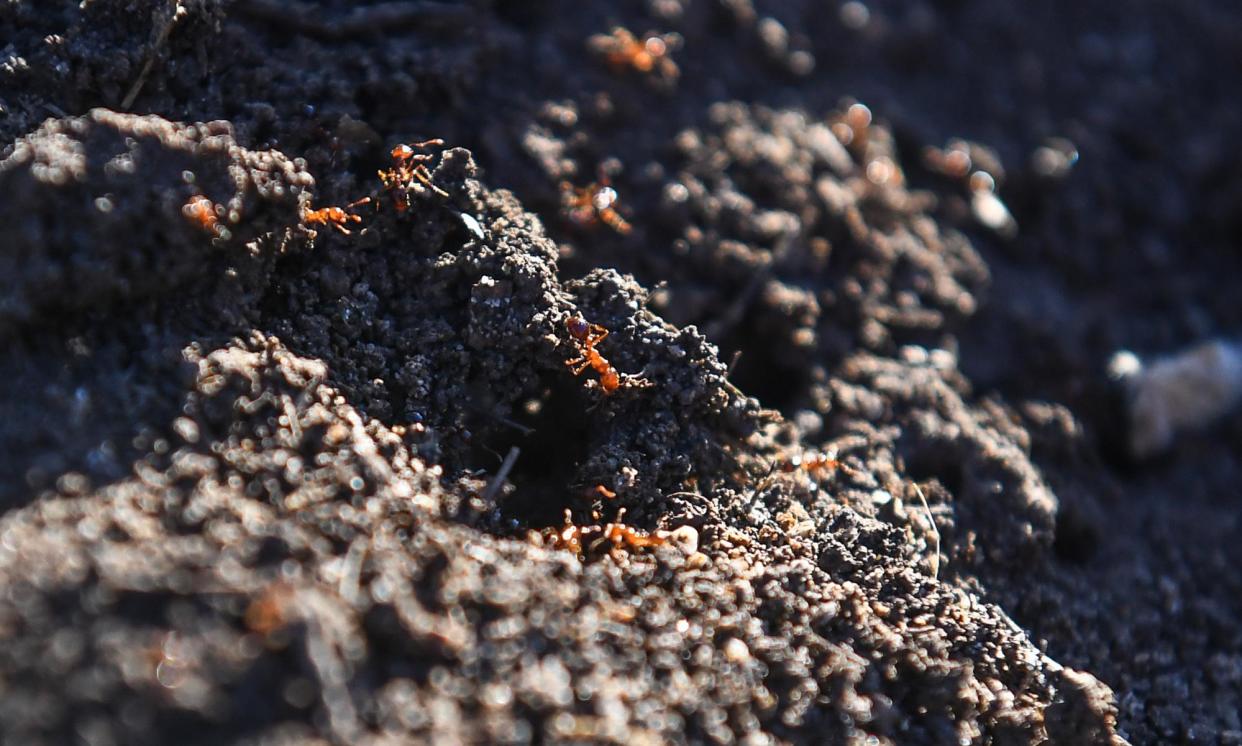‘Wildly toxic’ poison used on fire ants is killing native Australian animals, experts warn Senate inquiry

A “wildly toxic” chemical used to combat fire ants and the varroa mite in Australia is banned in Europe and harmful to humans – and it is poisoning waterways and killing native fauna, experts warn.
Fipronil acts as an insect nerve agent and is banned for use on crops in the EU, China, Vietnam and California because of its effect on pollinators. The insecticide was used in sugar baits across New South Wales in the now abandoned fight against the invasive varroa mite and has been injected into 35,539 fire ant nests in south-east Queensland and northern NSW since January 2023 as part of the national red imported fire ant eradication program.
But scientists are ringing alarm bells over its dangers, with a fire ants Senate inquiry last week warned about its deadly impacts on bees and other species and a lack of oversight by Australia’s chemical regulatory body.
Simon Mulvany, of Save the Bees Australia, told the committee, led by Senator Matt Canavan, that the broad-spectrum pesticide is “going to kill everything”, whether the intended target or not.
Lessons could be taken from the failed varroa mite baiting experience, the committee heard. The Australian Native Bee Association in 2022 warned that fipronil will remain active in the environment for up to three years. One bee can carry enough fipronil to kill an entire hive and native bees and other insects, reptiles, birds and mammals may die from fipronil poisoning.
Related: Australian $1.2bn program to eradicate red fire ants is a ‘shambles’, Senate inquiry told
Kate Mason of Community Voice Australia said that a government-commissioned report in 2006 raised concerns about fipronil’s effects on other species.
She also said a review of fipronil by the Australian Pesticides and Veterinary Medicines Authority had begun in 2002 and was yet to be completed.
The APVMA permitted the use of fipronil on varroa mite and fire ants and said the proposed regulatory decision will be published later this year – 22 years after reconsideration began.
The review was commenced after reports of skin reactions in humans and animals and adverse outcomes related to off-label use on rabbits, an APVMA spokesperson said.
Related: Australia fails to adequately monitor effect of agricultural chemicals in humans, report finds
Mat Landos, an aquatic veterinarian has extensively researched the effects of fipronil on aquatic animals and water systems. The University of Queensland professor and director of the Future Fisheries Veterinary Service told Guardian Australia that fipronil will enter the environment from fire ant nest injection sites.
“Fipronil is very, very long lived so will keep poisoning the ecosystem as it moves about. It can blow on the wind, and move in water,” he said.
A national fire ant eradication program spokesperson said it uses a low-dose fipronil formulation in direct nest injection and it was not used near waterways.
Landos said the government’s response was an “attempt to make something that is wildly toxic acceptable to deploy, even on floodplains”.
Related: The dirty dozen: 12 pesticides that are banned elsewhere but still used in Australia
CSIRO data from 2017 showed fipronil from farm run-off was detected in Queensland’s Logan River at high enough levels to kill prawn populations.
It is highly toxic to birds and there is a lack of data regarding its effects on amphibians, mammals, arthropods, reptiles – and humans.
A 2019 study found that fipronil transferred into foetuses and caused “infantile adverse health outcomes”, while 2020 research determined fipronil “can negatively affect male fertility leading to infertility”.
However a fire ant eradication spokesperson said the risk to the environment by using fipronil was far outweighed by the impact fire ants would have if not eradicated.
Australia was “a basket case” in that the chemical regulator answers to the department of agriculture, rather than to the department of health, as in Japan, the US and Europe, said Landos.
The APVMA spokesperson said all fipronil-containing products were individually assessed at the time of application to ensure the APVMA was satisfied they meet safety criteria.
“If there is an imminent risk to health, the APVMA can take immediate action”, the spokesperson said.
NSW MP Emma Hurst of the Animal Justice party said: “It is time for Australia to catch up to the rest of the world and ban fipronil.”
The Senate inquiry will host a third and final day of public hearings next week.


